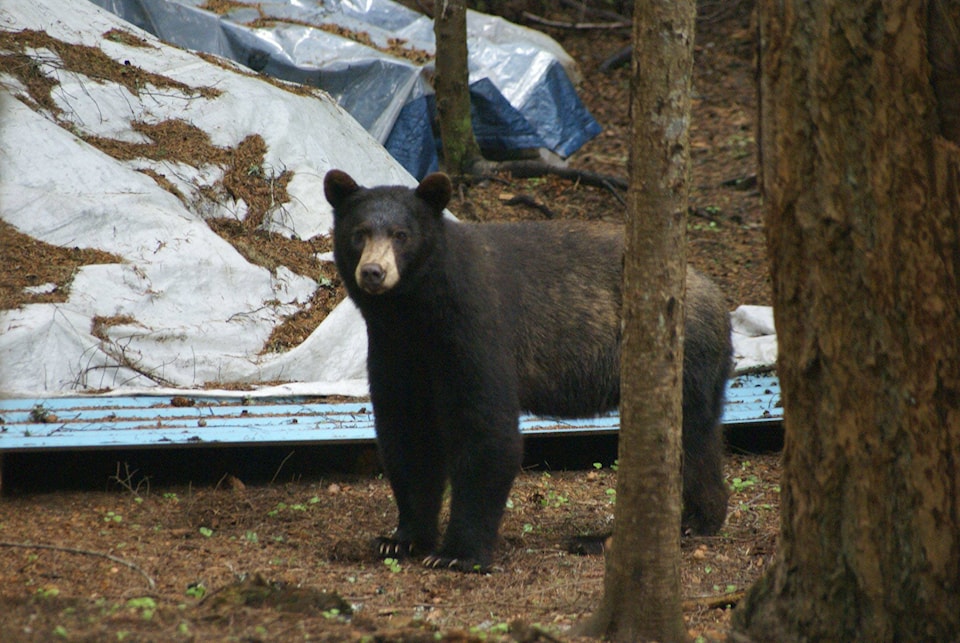The death of three bears last week in Sunshine Valley has highlighted the importance of residents being proactive in reducing attractants for wildlife.
The bears were “extremely habituated” and had to be killed, says Conservation Officer Don Stahl, as they had gained access to a home and physically attacked another home in the rural community.
“There’s no way we can relocate a bear like that,” he said of the three bears, so in extreme cases they do have to destroy these habituated bears. Two other bears in the area were “acting like normal bears” and left to wander off.
“Some people don’t want to call us,” Stahl says. “They figure it’s a death sentence for the bear.”
But that shouldn’t stop people from calling the RAPP Line (1-877-952-7277) to report bears who linger on properties, he underlines. He estimates in the 450 bear calls he’s had this year so far in his region, they’ve only had to destroy five or six bears. That’s less than one per cent of their calls, he adds.
And while rural residents are often more comfortable with bears in the neighbourhood than their urban counterparts, there are plenty of things all residents can do to keep them lingering and eventually becoming habituated, Stahl said.
“Most of the time when a bear shows up it’s because there is something to eat,” he says. It’s important to keep fruit trees near homes picked when the fruit is ripe, and to clean any rotten fruit from below them. Birds also don’t need to be fed with feeders during the summer when natural food sources are abundant, so residents can bring in their bird feeders.
One of the first things conservation officers try with bears is to move them along, a process they refer to as hazing. Residents who see a bear in their yard should go inside if they aren’t already, and open a window and bang pots and pans as a first try. Using an airhorn is also effective, Stahl says.
And it’s very possible to correct a situation where a bear has already gotten into a food source, such as garbage bins.
“They are there because there was something to eat,” Stahl says. “Once they know there is nothing there, they will move along.”
If making noise and removing food doesn’t urge the bears along, Stahl says there are still hazing options available to officers that they use.
“Go back inside. Definitely don’t go out there,” he says. “If it doesn’t leave, try yelling at it or making noise. If it still doesn’t leave, there are some options available to us. We have bear bangers, and we have rubber bullets and bean bag rounds for our shotguns.”
He said they will hit it in its hind quarters with those deterrents to discourage it from returning to the area, and quite often these steps all work.
“Usually it won’t be long before the bear leaves,” Stahl adds.
Shooting bears with actual bullets is their last option, he says.
READ MORE: Young bear killed downtown Chilliwack was habituated to humans
While he doesn’t suggest residents use bear bangers in the summer when fire ratings are high, they can be effective in the spring and the fall. Bear bangers look like a fat pen, and you buy shells that you shoot straight into the air — not at the bear or into vegetation. It mimics the sound of a high-powered rifle going off, Stahl says.
There are certain criteria for relocating bears, and habituated bears don’t do well in relocation programs. The bears from this region are often moved to the north end of Harrison Lake.
Stahl suggests all residents get familiar with other ways to reduce bear to human conflicts, through WildSafeBC. The website has extensive lists of how to discourage bears from your property, what to do in an encounter, and how to report a sighting.
He also suggests people in the Hope area contact Lydia Koot. She and other volunteers work hard to educate residents and visitors about reducing bear encounters. They also will help residents, usually seniors or those with disabilities, in removing fruit from trees and bushes.
Koot says last year they picked about 10,000 pounds of apples, and have been “gleaning” in the area for six years now. They are not a garbage removal service for piles of rotten fruit, she stresses, but are happy to come and pick fresh fruit. They give priority to areas where bears have already been sighted.
She says the service is important, and wants to remind people to never feed wildlife.
“It will cause almost all the time the death of the animal,” she says, “and causes a lot of stress and anxiety for the whole neighbourhood.”
Anyone wanting information on gleaning services can call Kloot at 604-860-4558, or 604-206-0415. To learn more about how to deal with bears and other wildlife, visit wildsafebc.com.
